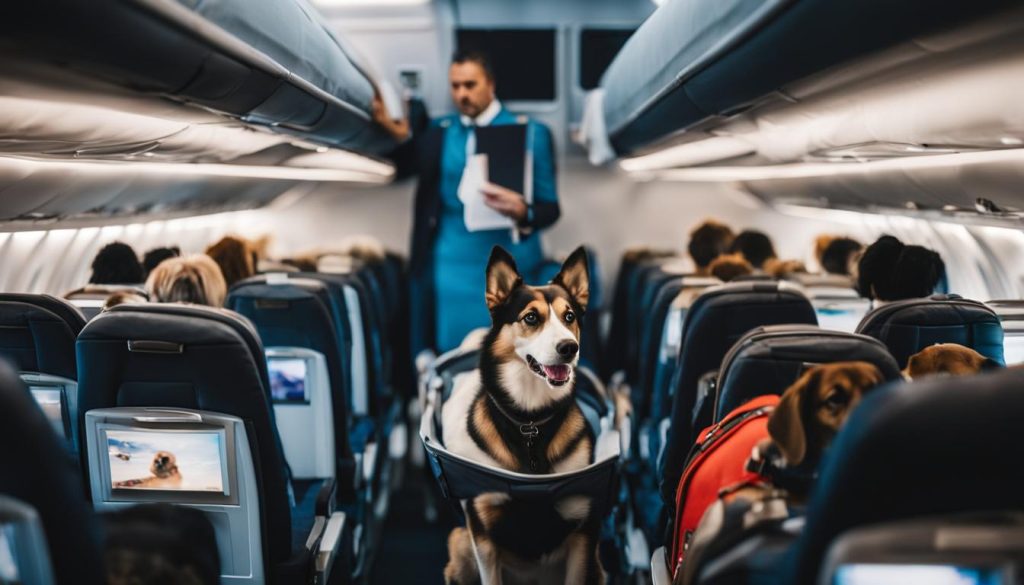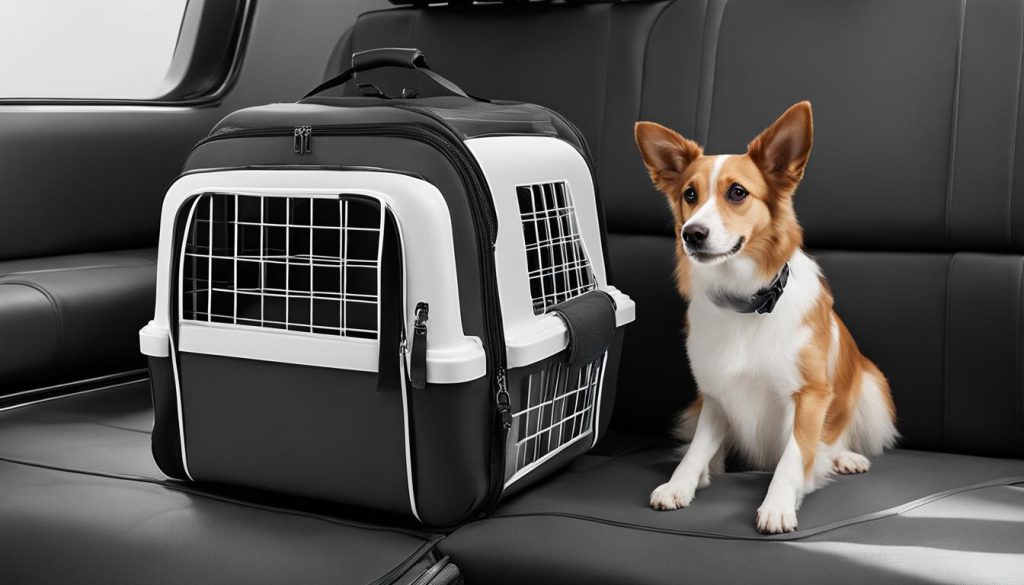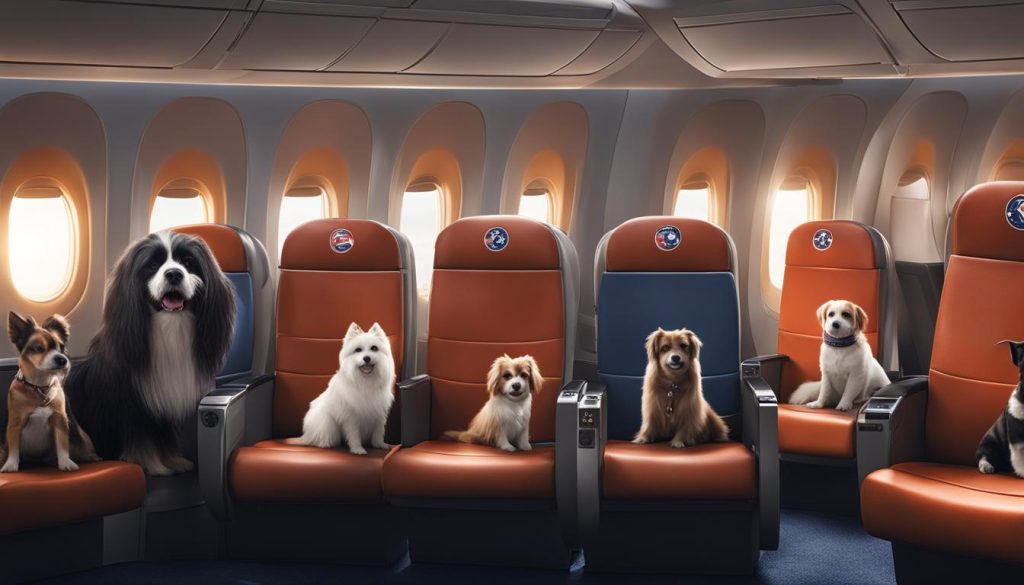Flying with multiple dogs can be a complex and challenging endeavor. Whether you’re relocating or embarking on a long trip, please plan ahead and ensure the comfort and safety of your furry companions. In this expert guide, I will provide you with valuable tips and information on traveling with multiple dogs by plane.
Before booking your trip, consult with your vet to determine if bringing your dogs along is necessary. Flying with pets should be reserved for situations that require it, such as permanent moves or extended vacations. Your vet can offer guidance on food, water, exercise, and any necessary medications to keep your dogs healthy and calm during the journey.
When it comes to choosing flights, opt for non-stop routes whenever possible. This minimizes travel time and reduces stress for both you and your dogs. Avoid busy holiday periods, as airports and planes can be crowded and overwhelming. Some airlines may allow dogs in the cabin if they can comfortably fit in a carrier under the seat. Others may offer the option to purchase an extra seat for larger dogs.
Key Takeaways:
- Prioritize your dogs’ comfort and safety when deciding whether to fly with them.
- Consult with your vet for guidance on food, water, exercise, and medication.
- Choose non-stop flights and avoid busy holiday periods.
- Check with airlines for their specific policies on dogs in the cabin.
- Consider purchasing an extra seat for larger dogs or those that don’t fit under the seat.
Are Dogs Allowed in the Cabin?
When it comes to traveling with your furry friends, one of the main concerns is whether dogs are allowed in the cabin of the plane. Most airlines do allow dogs in the cabin, but with certain restrictions. The general rule is that dogs must be able to comfortably fit in a carrier that can be placed under the seat in front of you.
However, some airlines, such as JetBlue, Alaska Airlines, and Etihad Airways, offer the option to purchase an extra seat for your dog, allowing for more space and comfort during the flight. regardless of whether your dog is in a carrier or has their own seat, they must remain in their designated area during taxi, takeoff, and landing. Once the flight is airborne, some airlines may allow dogs to be on laps or in a seat next to their owner.
Are Dogs Allowed in the Cabin?
While the specific policies may vary slightly between airlines, the general consensus is that dogs are indeed allowed in the cabin, as long as they meet the airline’s requirements and can fit comfortably in a carrier under the seat. It’s always a good idea to check with your chosen airline beforehand to ensure that you have all the necessary information and documentation for flying with your canine companion.
Additionally, if you’re considering flying with a larger dog, it’s worth exploring airlines that offer the option to purchase an extra seat. This can provide both you and your dog with more space and make the journey more comfortable for everyone involved.
| Airline | Policy |
|---|---|
| JetBlue | Allows dogs in the cabin in carriers that can fit under the seat. Extra seat option available. |
| Alaska Airlines | Allows dogs in the cabin in carriers that can fit under the seat. Extra seat option available. |
| Etihad Airways | Allows dogs in the cabin in carriers that can fit under the seat. Extra seat option available. |

Health Checklist for Flying With Your Dog
When preparing to fly with your dog, please prioritize their health and well-being. Here is a checklist of essential health requirements and considerations:
Vet Appointment
Schedule a visit to your veterinarian before your trip to ensure your dog is healthy and up-to-date on vaccinations. This is especially important if you are traveling internationally, as some countries have specific health requirements for pets entering their borders. Your vet can also provide any necessary medications and copies of prescriptions that your dog may need during the journey.
Anxiety Management
Flying can be stressful for dogs, so I would advise that you consider anxiety management options. Calming collars or natural supplements can help keep your dog relaxed during the flight. However, always consult with your vet before giving your dog any medication or supplements.
Brachycephalic Breeds
If you have a brachycephalic breed (dogs with short noses and flat faces), such as Bulldogs or Pugs, they may be more prone to respiratory challenges during air travel. I highly suggest that you talk to your vet about potential risks and precautions to ensure the safety of your dog during the flight.
By following this health checklist, you can help ensure that your dog is in the best possible condition for air travel. Taking the necessary precautions and consulting with your veterinarian will contribute to a smoother and safer journey for both you and your furry companion.

Airline and Travel Requirement Checklist
When flying with your dog, be aware of the specific requirements and regulations set by airlines and travel authorities. To ensure a smooth and hassle-free journey, here is a checklist of the key factors to consider:
- Health and vaccine requirements: Check the health and vaccine requirements at your destination and consult with your vet to ensure your dog is up to date with all necessary vaccinations.
- Pet carrier specifications: Make sure you have a well-ventilated and secure pet carrier that meets the airline’s specifications. The carrier should be size-appropriate and able to fit under the seat in front of you.
- Number of pets allowed in the cabin: Be aware of the limit on the number of pets allowed in the cabin. Some airlines may have restrictions on the total number of pets allowed on a flight.
- Advance notification: Inform the airline in advance that you will be traveling with a dog. This will allow them to make any necessary arrangements and ensure a smooth check-in process.
- Direct flights: Whenever possible, try to find direct flights to minimize stress and reduce the chances of delays or complications during layovers.
- Temperature restrictions: Be aware of any temperature restrictions for cargo travel, if applicable. Some airlines may have specific guidelines regarding when pets can and cannot be transported in the cargo hold based on temperature.
- Quarantine and health certificate requirements: Check if there are any quarantine requirements at your destination and ensure you have all the necessary health certificates and documents in order.
By following this checklist and being well-prepared, you can ensure a safe and comfortable journey for both you and your furry friend.

Airline and Travel Requirement Checklist
| Requirement | Description |
|---|---|
| Health and vaccine requirements | Check the health and vaccine requirements at your destination and consult with your vet to ensure your dog is up to date with all necessary vaccinations. |
| Pet carrier specifications | Make sure you have a well-ventilated and secure pet carrier that meets the airline’s specifications. The carrier should be size-appropriate and able to fit under the seat in front of you. |
| Number of pets allowed in the cabin | Be aware of the limit on the number of pets allowed in the cabin. Some airlines may have restrictions on the total number of pets allowed on a flight. |
| Advance notification | Inform the airline in advance that you will be traveling with a dog. This will allow them to make any necessary arrangements and ensure a smooth check-in process. |
| Direct flights | Whenever possible, try to find direct flights to minimize stress and reduce the chances of delays or complications during layovers. |
| Temperature restrictions | Be aware of any temperature restrictions for cargo travel, if applicable. Some airlines may have specific guidelines regarding when pets can and cannot be transported in the cargo hold based on temperature. |
| Quarantine and health certificate requirements | Check if there are any quarantine requirements at your destination and ensure you have all the necessary health certificates and documents in order. |
Choosing the Right Pet Carrier for the Cabin
When flying with your dog in the cabin, I would advise that you choose the right pet carrier to ensure their comfort and safety throughout the journey. The pet carrier must fit under the seat in front of you, so consider the dimensions and specifications required by the airline.
Hard-sided carriers are a popular choice as they offer sturdy protection for your dog. These carriers must meet the maximum dimensions of the aircraft to ensure they fit properly. On the other hand, soft-sided carriers are more flexible and can be slightly larger, but they should still fit without excessive collapsing.
One highly recommended airline-approved carrier is the Sherpa Original Deluxe Airline-Approved Dog & Cat Carrier Bag. This carrier is designed to meet most airline requirements and provides a comfortable and secure space for your dog during the flight. Its well-ventilated design ensures proper airflow, and the adjustable straps allow for easy carrying.

When choosing a pet carrier, prioritize the safety and well-being of your dog. Ensure that the carrier is secure, with sturdy zippers or latches to prevent any accidental openings. Additionally, consider the size-appropriateness of the carrier, allowing your dog enough room to move comfortably but not too much space that they may be jostled during turbulence.
By selecting the right pet carrier for the cabin, you can provide your dog with a comfortable and secure travel experience, making the journey a positive one for both of you.
Airline-by-Airline Guidelines for Flying With Dogs
When it comes to flying with dogs, familiarize yourself with the specific guidelines of each airline. Different airlines have different rules and restrictions, so please know what to expect before booking your flight. Here is a breakdown of some popular airlines and their guidelines for flying with dogs:
Alaska Airlines
Alaska Airlines allows dogs to travel both in the cabin and in cargo. In the cabin, they must be kept in an approved carrier that fits under the seat in front of you. In cargo, there are specific requirements for the size and type of carrier. there may be breed restrictions and additional fees for traveling with dogs in cargo.
American Airlines
American Airlines allows dogs in the cabin on most flights, as long as they meet certain requirements. Dogs must be able to fit in an approved carrier that fits under the seat in front of you. However, there are restrictions on traveling with dogs to certain destinations, so check the specific guidelines for your intended location.
JetBlue Airways
JetBlue Airways offers the option to purchase an extra seat for larger dogs, allowing them to travel in the cabin. Dogs must remain in an approved carrier during taxi, takeoff, and landing, but may be allowed on laps or in a seat next to the owner during the flight. I recommend that you check the specific guidelines and restrictions of JetBlue Airways before planning your trip.
These are just a few examples of the guidelines set by different airlines. I highly suggest that you check the specific requirements of your chosen airline and destination before flying with your dog. Try to consider the size, age, and breed restrictions that may apply. By following the airline-specific guidelines, you can ensure a smooth and comfortable journey for both you and your furry friend.

| Airline | Cabin Travel | Cargo Travel | Breed Restrictions | Additional Fees |
|---|---|---|---|---|
| Alaska Airlines | Allowed | Allowed with specific requirements | May apply | May apply |
| American Airlines | Allowed on most flights | Not allowed to certain destinations | May apply | May apply |
| JetBlue Airways | Allowed with an extra seat | Not allowed | N/A | N/A |
Tips for Flying With Your Dog
Preparing your dog for a flight can help reduce anxiety and ensure a smoother travel experience. Here are some expert tips to consider:
- Get your dog accustomed to airport surroundings by taking them on short visits to increase familiarity with the sights and sounds.
- Bring a potty pad and dispose of waste in designated areas to maintain cleanliness during the journey.
- Avoid feeding your dog right before the flight to prevent discomfort and potential accidents.
- Book a window seat if possible, as it provides a quieter and more secure environment for your dog.
- Inform the airline in advance about your pet’s travel plans to ensure they are well-prepared to accommodate your needs.
- Follow Transportation Security Administration (TSA) guidelines for carrying small pets through security checkpoints.
- Consider specific needs and anxiety management techniques for your dog, such as using calming aids or playing soothing music during the flight.
By following these tips, you can help make the flying experience as comfortable and stress-free as possible for your furry companion.

Considerations for Traveling With Large Dogs or in Cargo
Traveling with large dogs or choosing to transport them in cargo requires careful consideration and planning to ensure their safety and well-being throughout the journey. While most airlines allow dogs in the cabin if they can fit comfortably in a carrier under the seat, larger dogs may need to be checked as excess baggage or transported in cargo.
You should note that flying with dogs in cargo carries more risks than traveling with them in the cabin. The cargo hold can be stressful and potentially dangerous for dogs due to temperature fluctuations, noise, and rough handling. Additionally, there have been instances of pets getting lost or injured during cargo transportation.
Therefore, it is good practice to monitor your dog’s stress levels and consider alternative transportation methods if possible, such as driving or using pet-friendly airlines that prioritize the well-being of animals. If flying in cargo is unavoidable, communicate with the airline to understand their specific regulations and safety precautions. Be aware of temperature restrictions and choose flights during cooler times of the day or year to minimize the risk of extreme heat or cold.
| Considerations for Traveling With Large Dogs or in Cargo | |
|---|---|
| Risks of flying with dogs in cargo | Temperature fluctuations |
| Noise and rough handling | |
| Potential loss or injury | |
| Monitor stress levels | |
| Consider alternative transportation methods | |
| Communicate with the airline | |
| Choose flights during cooler times |
When traveling with large dogs, it is essential to prioritize their comfort and well-being. Ensure that they have ample space to move and lie down comfortably during the journey. Use sturdy and well-ventilated crates that meet the airline’s specifications for cargo transportation. Provide familiar bedding, toys, and treats to help reduce anxiety and make them feel more secure.
To sum it up, while flying with large dogs or transporting them in cargo can be challenging, taking the necessary precautions and considering alternative transportation options can help mitigate the risks and ensure the safety and well-being of your furry companion.
Final Thoughts
To sum it up, flying with multiple dogs requires careful planning and consideration. Before booking a trip, assess whether it is truly necessary to bring your dog along. Consult with your vet to ensure your dog is fit for travel and discuss any specific requirements or health concerns.
When it comes to choosing airlines, check their guidelines and requirements for flying with dogs. Some airlines allow dogs in the cabin, while others may require them to be checked as excess baggage or travel in cargo. Prioritize your dog’s comfort and safety, and consider alternative transportation methods if flying poses significant risks.
Throughout the travel process, follow all airline regulations, including those regarding pet carriers, health certificates, and vaccination requirements. Book non-stop flights whenever possible to minimize stress for your dogs, and avoid busy holiday periods to reduce the chances of complications.
Ultimately, your dog’s well-being should always be the top priority. Consider the specific needs and anxiety management techniques for your dogs, and take measures to ensure their comfort during the journey. By taking the necessary precautions and being well-prepared, you can make flying with multiple dogs a safe and successful experience.
FAQ
Is it allowed to bring dogs in the cabin when flying?
Yes, some airlines allow dogs in the cabin if they can comfortably fit in a carrier under the seat. Others may offer the option to purchase an extra seat for larger dogs.
What are the health requirements for flying with a dog?
Before flying, schedule a vet appointment to ensure your dog is healthy and up-to-date on vaccinations. Bring necessary medications and copies of prescriptions.
What are the airline and travel requirements for flying with a dog?
Check the health and vaccine requirements at your destination. Make sure to have a well-ventilated carrier that meets the airline’s specifications. Inform the airline in advance and try to find direct flights. Check the quarantine, vaccination, and health certificate requirements.
How do I choose the right pet carrier for the cabin?
The pet carrier must fit under the seat in front of you. It should be size-appropriate, well-ventilated, and secure. Research airline-approved carriers like the Sherpa Original Deluxe Airline-Approved Dog & Cat Carrier Bag.
What are the airline-specific guidelines for flying with a dog?
Different airlines have different rules and restrictions for flying with dogs. Always check the specific guidelines of your airline before booking a flight. Restrictions may apply based on the size, age, and breed of the dog.
What are some expert tips for flying with a dog?
Get your dog accustomed to airport surroundings beforehand. Bring a potty pad and dispose of waste in designated areas. Avoid feeding your dog right before the flight. Book a window seat and inform the airline in advance.
What are the considerations for traveling with large dogs or in cargo?
Large dogs that can’t fit in a carrier under the seat may need to be checked as excess baggage. This option should be carefully considered due to the risks involved. If flying in cargo, be aware of weather restrictions and specific regulations.
What are the final thoughts on flying with dogs?
Flying with dogs requires careful planning and consideration. Assess the necessity of bringing your dog on the journey and prioritize their comfort and safety throughout the entire travel process. Consider alternative transportation methods if flying poses significant risks to your dog’s well-being.






